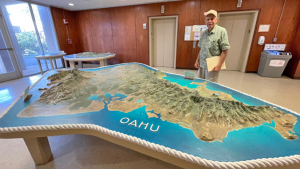
The historical biogeography of mind-altering drug plants—such as cannabis, kava, betel nut, ephedra and the opium poppy—are a specialty of a renowned environmental specialist who has served more than 50 years at the University of Hawaiʻi at Mānoa.

School of Life Sciences Professor Mark Merlin’s pioneering research interests include exploring how ancient cultures used plants for healing or religious purposes, investigating how humans have changed the environment over time in places such as Hawaiʻi and other tropical Pacific island groups through agriculture or urbanization, and studying how traditional knowledge of plants can help us protect the environment and support sustainability today.
Merlin, who also earned graduate degrees from UH Mānoa, recalled the many professors with whom he worked and the thousands of students that he taught. For example, he worked with UH Sea Grant longtime facilitator, the late Peter Rappa, when current UH President David Lassner was earning his PhD in communication and information sciences. Merlin also taught notable student athletes, including Jim Donovan, former UH lineman and later athletic director, numerous UH football athletes who had careers in the NFL, as well as current Rainbow Warrior football coach Timmy Chang. To all of them, as well as to all his students over his years at UH Mānoa, including many teaching assistants who have gone into positions in academia, Merlin says simply, “thank you.”
Spotlighting Hawaiʻi plants

Merlin is proud of his work with a group of scholars to replace continental U.S. ecological examples, such as pine trees and squirrels, used in Pacific regional school textbooks for many years with Hawaiian native examples, including ʻiʻiwi (an endemic species of Hawaiian honeycreeper), ʻōhiʻa lehua (a keystone tree in Hawaiʻi) and koa (species of large flowering tree native to Hawaiʻi). Merlin is also proud of the two guidebooks that he created in the 1970s called Hawaiian Forest Plants and Hawaiian Coastal Plants used by a large variety of people for more than 45 years.
“These field guides got so many people interested in, first of all, exercise, getting out and hiking,” Merlin said. “Second of all, recognizing native plants versus alien plants, especially distinguishing between benign alien plants and those that have become invasive. And then overall developing interest in conservation and protection of Hawaiʻi’s unique natural environment and natural history.”
Finding his research passion
Merlin grew up in the Hollywood area. He earned his undergraduate degree from the University of California, Santa Barbara. During his college years as a student, protests around the Vietnam War were prevalent across college campuses, Merlin said, and so was the use of psychoactive substances besides alcohol.
He was invited to apply at UH Mānoa and offered a graduate teaching position, eventually earning his master’s and PhD degrees in geography. It was here that he followed his research interest of learning more about plants and the environment.
“I said to myself, if I’m going to spend two years studying for and writing a thesis about something, it better be something interesting. I thought, ‘Back to pot, back to cannabis, back to pakalolo,’” Merlin said. “I started by asking ‘Where did this plant come from? Who started using it? Why did they use it?’ And then I did some research on that and I realized, it’s a super multi-purpose species. So that supported my growing interest in botany, ecology, and ethnobotany, in particular.”
It was this launch pad that inspired Merlin to contribute and foster environmental education and preservation of traditional ecological and ethnobotanical knowledge.
Some of his groundbreaking books, Man and Marijuana (1972), On the Trail of Ancient Opium Poppy (1984), Kava: The Pacific Drug (1992, co-authored) and Cannabis: Evolution and Ethnobotany (2013, co-authored), received critical acclaim. The latter was the co-winner of the Mary Klinger Award for Best Ethnobotany Book by the Society for Ethnobotany. In addition, his more recently co-authored book, Plants and People of the Marshall Islands (2018) was the winner of the Mary Klinger Award.
Merlin also earned numerous honors and accolades, including selection by Gov. George Ariyoshi to serve as an expert environmentalist for a state pesticide committee 1980–88, and a “Lifetime Volunteer Award” (2018) from the Hawaiʻi Nature Center “in appreciation for your many years of dedicated service, devotion and commitment to connecting children and families to nature!”
—By Marc Arakaki

